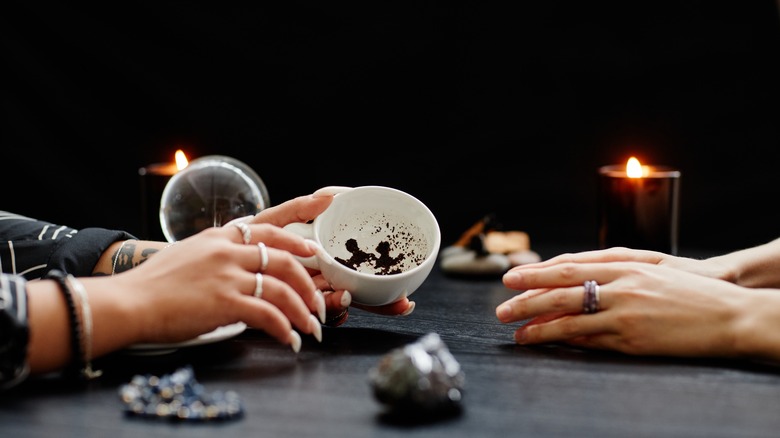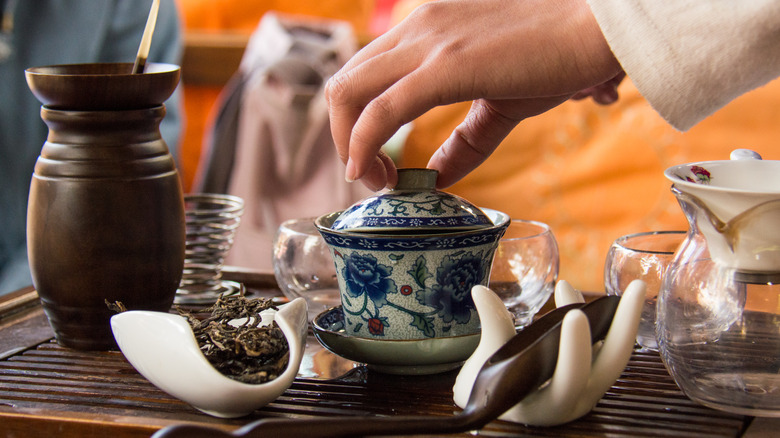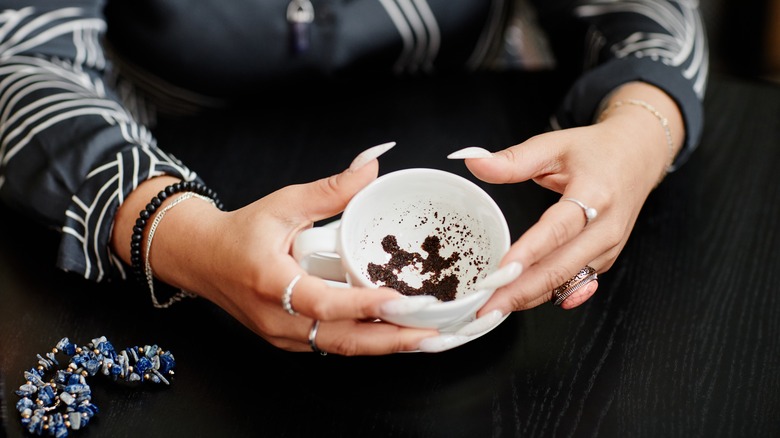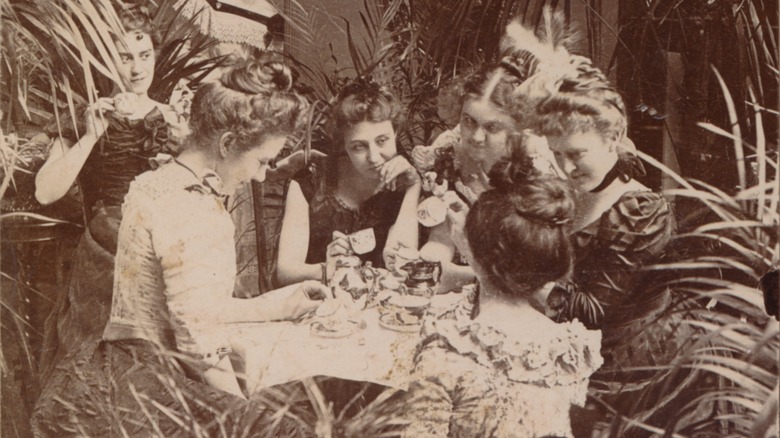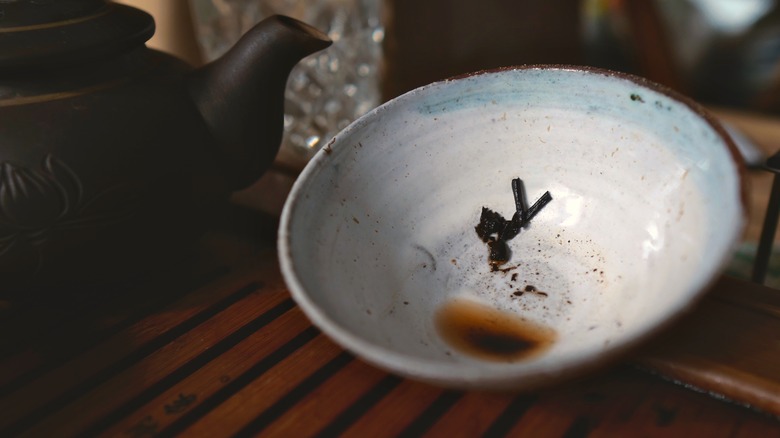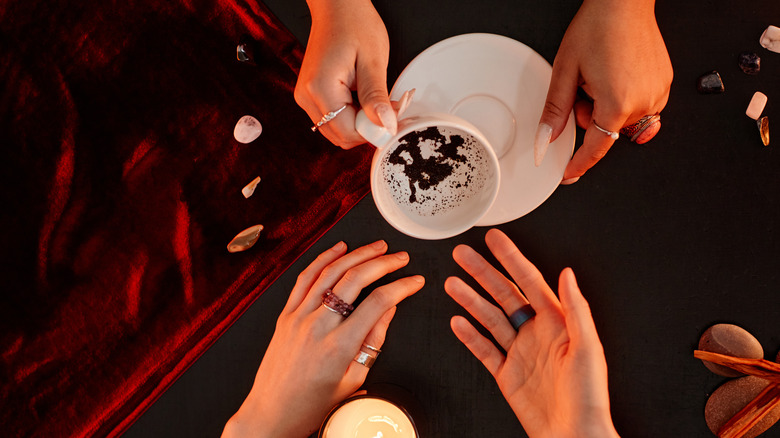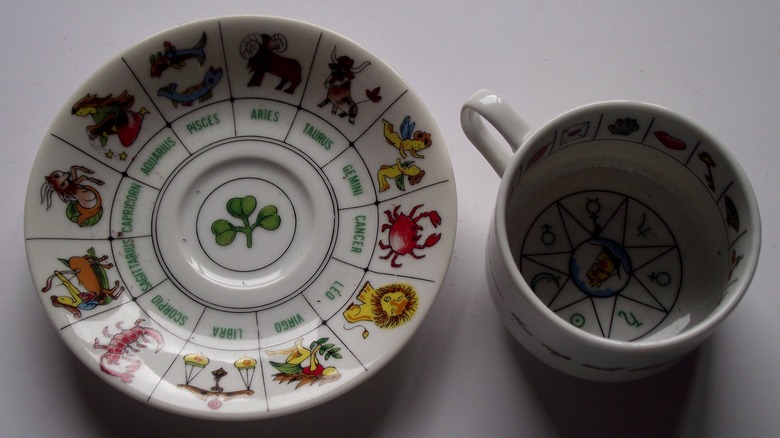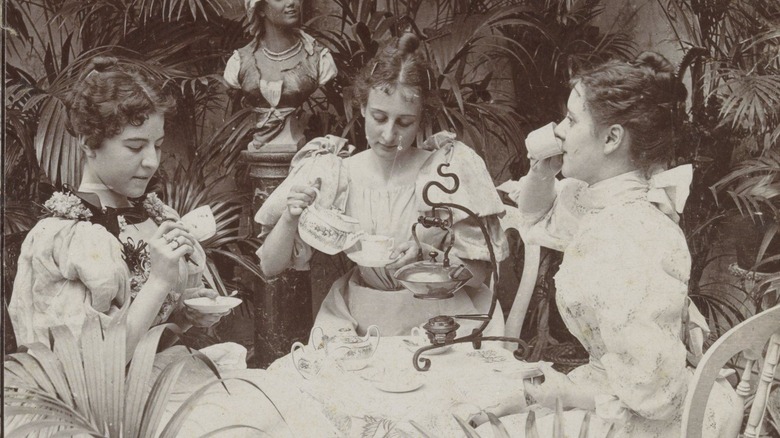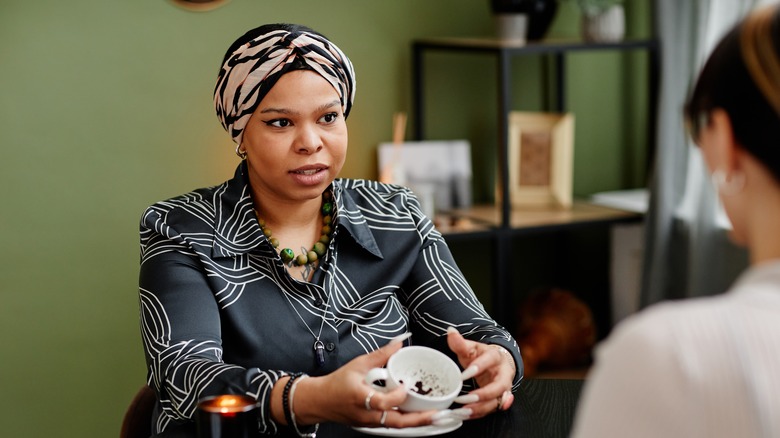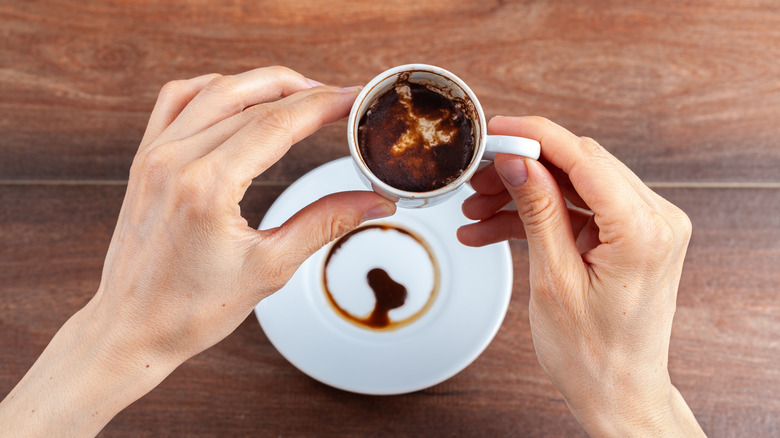The Centuries-Old Art Of Reading Tea Leaves (And Why Victorians Loved It)
What's in a cup of tea? For many, the answer is pretty mundane: tea, perhaps with a bit of cream or sugar. It's a nice breakfast beverage or afternoon pick-me-up, but that's all there is to it.
Not so fast. Besides the deep history of tea as both a plant and a cultural phenomenon, some maintain that your seemingly plain cuppa may contain the future. At any rate, with the right sort of tea and an open mind, they say that you might be able to foretell what lies ahead. Known as tasseography or tasseomancy, the art of reading the shapes left behind in a cup of loose-leaf tea has been around for centuries. In many incarnations, it happens around a table, perhaps in a dimly-lit tea room. The person whose fortune is being told finishes their drink, swirls the cup a few times, and then turns it over onto a saucer to let the last bits of tea drain out. Then, the reader picks up the cup and looks intently into it to see shapes that may predict a person's fate.
For much of its history, tasseography has been treated as a quaint distraction best left to bored ladies lingering in the tea room. But the history of tasseography has a lot to say about international trade, feminism, and the Victorian love of all things spooky, among other things. Here's the real truth begging the art of tea leaf reading, and why it's here to stay.
Tea leaf reading may have got its start in China
The origins of tasseography may come from China, according to numerous accounts. Some of the earliest cups that could have been used for tea leaf reading may come from the Ming dynasty between A.D. 1368 and 1644. Known as gaiwan, these lidded, handleless, flared cups were made from light-colored porcelain. The shape allows tea leaves to clump together in potentially interesting shapes — just right for someone looking to pick out a fortune after they'd downed their cup of tea.
While these first steps in tasseography are hard to prove for certain, it's very clear that tea got its start in and around China. The tea plant is native to this region and, if you go by the stories, was first enjoyed as a beverage around 2,700 B.C. For those who want a more concrete answer, tea begins to show up in the written record by A.D. 350. Over the centuries, tea plantations began to spring up farther afield, from Japan to Indonesia to India. Eventually, Dutch traders, working under the aegis of the Dutch East India Company, brought tea leaves to Europe in the 17th century. It could well be that they also brought quite a bit of tea lore, including the art of reading someone's fortune in the tea leaves at the bottom of their cup.
One book claimed tasseography came from the Scottish Highlands
The oldest-known English language book on tasseography was published in the 18th century. Titled "Tea-Cup Reading and Fortune-Telling by Tea Leaves," it was supposedly written by an unnamed "Highland Seer" hailing from the wilds of northern Scotland. It references a rural, homey setting, in which a fortune-telling "spae-wife" will look into the form of leaves left behind in someone's cup of tea to tell their future. As "Tea-Cup Reading" maintains, these figures mostly used the dregs of a teacup to foretell rather mundane domestic things, from the arrival of letters to how much their home goods would sell for on the market.
"Tea-Cup Reading" makes it sound as if the spae-wives of Scotland were pretty innocuous as they peered into the bowl of a teacup, safely ensconced in cozy cottages in the rural Highlands. However, a closer look at the folklore of the region gives them a bit more of an edge. The tales of the Orkney Islands in the far north of Scotland say that the spae-wives were wise and imbued with supernatural power. Luckily, they were also generally believed to be good-natured, if a bit eerie, and definitely not someone to cross. When they weren't reading tea leaves, they might have been found working their power against evil witches or other misfortunes — perhaps even those predicted at the bottom of a cup.
Reading tea leaves is accessible divination
Before tea leaf reading became popular, divination could take quite a lot of effort. Sure, someone might claim to foretell the future through visions or carefully considering signs that popped up in their surroundings, but where's the razzle-dazzle in that? Anyone who wanted a bit more showmanship in their divination would need to procure the right equipment and set aside a fair amount of time in their calendar. Ancient seers might have to look at the intricate patterns of a sacrificed animal's innards, in a practice known as haruspicy. Scrying, in which someone gazes into a reflective material like water or the now-classic crystal ball, may have made the material more accessible but takes time. And molybdomancy, which requires that someone pour molten metal into water, runs the risk of incurring burns and carries the occasional brush with lead exposure.
Tasseography, by contrast, is a downright pleasant way to tell the future. So long as you're careful with the boiling water needed to brew the leaves, the next step in this process is to enjoy a relaxing cup of tea by yourself or with a friend. Tea became more affordable and easily procured in 17th-century Europe and later, thanks in part to doctors' recommendations and competitive pricing. It eventually proved an easy way to engage in a fun bit of fortune-telling. It was certainly far more pleasant to brew a cup than get out the molten lead setup or a hefty crystal ball.
Victorians went wild for reading tea leaves
The Victorians loved to get a little weird. This era saw people on both sides of the Atlantic engage enthusiastically with the spooky side of things in ways both big and small. Case in point: the Fox Sisters came out of rural 1840s New York claiming to have communicated with the spirit of a dead peddler buried beneath their house, eventually turning this wild story into a series of lucrative seances and a new movement known as spiritualism.
Even if they weren't trying to talk to the dead, Victorians might still be found ostentatiously honoring them with somber mourning dresses, memorial jewelry made from a dead loved one's hair, or a treasured postmortem photograph. With this flair for the dramatic — and borderline obsession with the occult — paired with an ongoing love of tea in Britain, especially, it's no wonder that tasseography flourished.
Victorian proto-goths weren't the only ones who made tea leaf readings popular, however. The final decade of the 19th century also saw the rise of psychoanalysis under the direction of Sigmund Freud and his colleagues. This new frontier in psychiatry demanded much consideration of the subconscious, a roiling mass of emotion and impulse that many found pretty compelling. Perhaps that's also why the Victorians seemed to really cotton to the practice of reading tea leaves. Not only was tea widely enjoyed in Britain and beyond, but the spirit of the times was just right for some mystical navel-gazing after teatime.
Romani people are linked to tasseography
Around the time that many people of the Victorian era were getting into tasseography, the practice also became associated with the Romani people. Also known as the Roma, this ethnic group began to travel out from their original homelands in India sometime during the medieval period, taking up a nomadic lifestyle throughout the world. In Europe, they gained a complicated reputation, with many Gadje (as Romani sometimes call outsiders) wrongfully assuming that these people were all rootless criminals. Perhaps also because they were itinerant and separate from more settled communities (in part because of frequent non-Romani efforts to exile them), Romani people likewise gained a reputation for exotic mysticism.
Thus was born the romanticized image of a Romani woman in a dimly-lit tea parlor, reading someone's future out of someone's cup. At first, it appears that some went from household to household, knocking on doors and offering to read the leaves. As the 19th century continued, the association between the Romani and tea leaf reading was strong enough that some made money reading fortunes in homes and tea houses for well-heeled outsiders.
As Katelan Foisy told StyleCaster, her Romani grandmother provided her with an extensive knowledge of herbal medicine and dream interpretation that served Foisy well when she became interested in tasseography. Foisy also said that she felt a kinship with distant Romani ancestors who may have read the tea leaves to make a living.
Tea leaf reading has a feminist history
When asked to conjure up a scenario of a mysterious tea leaf reading, chances are pretty good that we all land on a few key details: curtains drawn, a hushed atmosphere, a tea set pushed to the side. And who is doing the reading? In our collective imagination, that person is likely a woman. That's for a good reason, as tasseography is often associated with women, from itinerant Romani fortune tellers to women of the Victorian era. As such, many families claim that the knowledge of how to interpret the dregs of leftover tea leaves was passed down amongst the women of their households. Given how closely women were associated with the domestic sphere and spiritualism, this link between femininity and tasseography is hardly surprising.
More broadly, women and tea have long been associated. As the story goes, tea was first made popular in England by Catherine of Braganza, the wife of the monarch, Charles II, who reigned during the 17th century. As tea became more popular and widely available to all classes, Britain developed a genteel tea-drinking culture that allowed women to gather. They even sometimes ran tea rooms themselves, earning money at a time when entrepreneurial opportunities were little more than pipe dreams for many women. That didn't extend only to well-heeled middle-class women, either. Likewise, some Romani women took up tasseography to make money when other ways of providing for themselves and their families were closed to them.
Diviners can use special tasseography cups
Though most tea leaf readers will likely tell you that any teacup with sloping sides will do, the Victorian love of maximalism wasn't going to let such simplicity stand. For those with enough interest and disposable income, specially-designed cups were available, with clearly marked sections and symbols meant to make reading the dregs easier. Some might have signs associated with the zodiac, while others riffed on the symbolism passed down in writings about the practice. Some sets even came complete with a handy guidebook that claimed to help with interpreting the shape of the tea leaves, though this may have also leached some of the mysticism and skill from a reading.
Today, there are so many kinds of tasseography cups out there that one can create a pretty diverse taxonomy of them. Some focus on astrological symbols, others on numbers, or on unique symbols. Some fortune-telling tea cups combine a bit of everything in their designs. While some manufacturers were happy to include a separate guide, "self-reading" cups have interpretations printed directly on the cup or saucer. Purists may say that this all dampens the power of really paying attention to the tea leaves and coming up with your intuitive interpretation. Yet, it's clear that, if nothing else, these tasseography cups can be fascinating works of art in themselves.
[Featured image by Malcolm Lidbury via Wikimedia Commons | Cropped and scaled | CC BY-SA 3.0]
Many claim a specific tea drinking ritual must be followed
How do you actually read the leaves? That largely depends on who you ask, though many start with loose-leaf tea, as the little bits in a tea bag only create an unappealing mud if you split it open and attempt a reading. You'll also want to avoid teas with pieces of flowers or fruit, which can blur symbols. Many tasseographers pare it down even further, urging drinkers to use simply tea leaves and water — no cream or sugar, please.
When it comes to drinking the tea, it's almost always the person whose fortune is to be told who is doing the consumption. When there's only a small amount of liquid left in the cup, the drinker is to swirl the vessel — in their left hand and clockwise, if you care to get that specific — then quickly invert the vessel onto a saucer. Once the tea is drained out, the symbol gazing and interpretation can begin. Or maybe that's counterclockwise, at least according to the recollections of historian Alec Gill, who witnessed the practice while growing up in 1950s Britain (via NPR).
Perhaps the exact movements aren't as vital as being in the right state of mind. Speaking to Refinery29, authors and witches Sandra Mariah Wright and Leanne Marrama said that getting into a calm and meditative state will put you in the right state of mind for reading the leaves. Everything else could be a bit of fancy table dressing.
[Featured image by Rijksmuseum via Wikimedia Commons | Cropped and scaled | CC0 1.0]
Tea leaf symbols have many interpretations
Tea leaf symbols spotted near the rim of the cup may represent events in the near future, while those deeper into the bowl refer to what's to come farther ahead. Others claim that you should divide the cup into halves, with one side reserved for short-term predictions and the other for the longer view. The 18th-century "Tea-Cup Reading and Fortune-Telling by Tea Leaves" offers up a comprehensive glossary of symbols and meanings, with boats foretelling a visit from a friend, a kangaroo heralding a rival, and pears spelling out a financial windfall.
However, having a list of these signs at the ready may not be the point of this whole exercise. As authors and witches Sandra Mariah Wright and Leanne Marrama told Refinery29, figuring out what you're seeing at the bottom of the cup is up to you. Personal resonance can trump pat definitions in other books, so a healthy dose of self-reflection and meditation is perhaps the best reference of all.
The most skeptical may push aside all these interpretations and point to a different explanation: pareidolia. That's the common phenomenon where people tend to see patterns and shapes where such things don't really exist. If you've ever found familiar shapes in clouds or picked out a human face on a piece of toast, you've engaged in an act of pareidolia. It's easy to see how this could apply to anyone staring at the clumps of tea at the bottom of a cup.
Similar methods can be used with coffee
While tea leaf reading may have widespread notoriety, it's not the only beverage-based form of divination in town. Pretty much any drink that leaves behind material in a cup or glass can be used for a similar purpose, with wine sediment and coffee grounds being two of the more popular materials over the years. Turkish coffee is especially suited to this sort of fortune-telling, with a brewing method that uses finely ground coffee and leaves behind a thick, dark sludge in the cup that can form intriguing shapes.
Known as fal in Turkish (which simply translates to fortune), this method of divination is widely taken as a casual, post-coffee pastime in much the same manner that tea leaf reading has carried on over the generations. Coffee readers interpret the shapes formed by left-behind grounds in similar ways, too. Supposedly, the practice became especially popular in the harems of the Ottoman Empire, where bored women who were confined to the home entertained themselves with alternating rounds of caffeine and fortune-telling.
Meanwhile, some coffee drinkers who draw on traditions from Latin American countries may peer into the steam rising from their coffee or into the depths after adding a glug of cream. They're also looking for shapes that might illuminate the future, much like tea leaf readers, only they happen to be gazing into the changing, ephemeral liquid for information.
